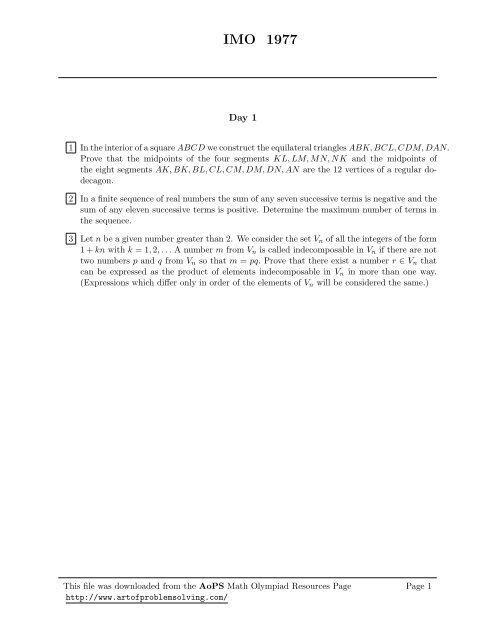International Competitions IMO 1977 - Art of Problem Solving
International Competitions IMO 1977 - Art of Problem Solving
International Competitions IMO 1977 - Art of Problem Solving
Create successful ePaper yourself
Turn your PDF publications into a flip-book with our unique Google optimized e-Paper software.
<strong>IMO</strong> <strong>1977</strong><br />
Day 1<br />
1 In the interior <strong>of</strong> a square ABCD we construct the equilateral triangles ABK, BCL, CDM, DAN.<br />
Prove that the midpoints <strong>of</strong> the four segments KL, LM, MN, NK and the midpoints <strong>of</strong><br />
the eight segments AK, BK, BL, CL, CM, DM, DN, AN are the 12 vertices <strong>of</strong> a regular dodecagon.<br />
2 In a finite sequence <strong>of</strong> real numbers the sum <strong>of</strong> any seven successive terms is negative and the<br />
sum <strong>of</strong> any eleven successive terms is positive. Determine the maximum number <strong>of</strong> terms in<br />
the sequence.<br />
3 Let n be a given number greater than 2. We consider the set V n <strong>of</strong> all the integers <strong>of</strong> the form<br />
1 + kn with k = 1, 2, . . . A number m from V n is called indecomposable in V n if there are not<br />
two numbers p and q from V n so that m = pq. Prove that there exist a number r ∈ V n that<br />
can be expressed as the product <strong>of</strong> elements indecomposable in V n in more than one way.<br />
(Expressions which differ only in order <strong>of</strong> the elements <strong>of</strong> V n will be considered the same.)<br />
This file was downloaded from the AoPS Math Olympiad Resources Page Page 1<br />
http://www.art<strong>of</strong>problemsolving.com/
<strong>IMO</strong> <strong>1977</strong><br />
Day 2<br />
1 Let a, b, A, B be given reals. We consider the function defined by<br />
f(x) = 1 − a · cos(x) − b · sin(x) − A · cos(2x) − B · sin(2x).<br />
Prove that if for any real number x we have f(x) ≥ 0 then a 2 + b 2 ≤ 2 and A 2 + B 2 ≤ 1.<br />
2 Let a, b be two natural numbers. When we divide a 2 + b 2 by a + b, we the the remainder r<br />
and the quotient q. Determine all pairs (a, b) for which q 2 + r = <strong>1977</strong>.<br />
3 Let N be the set <strong>of</strong> positive integers. Let f be a function defined on N, which satisfies the<br />
inequality f(n + 1) > f(f(n)) for all n ∈ N. Prove that for any n we have f(n) = n.<br />
This file was downloaded from the AoPS Math Olympiad Resources Page Page 2<br />
http://www.art<strong>of</strong>problemsolving.com/

















